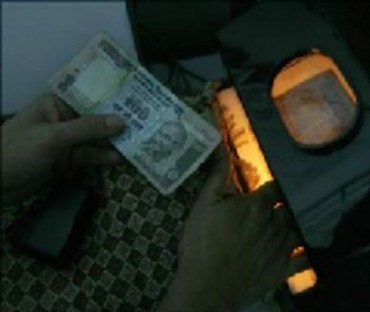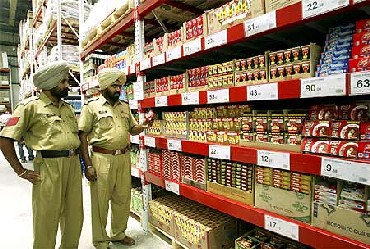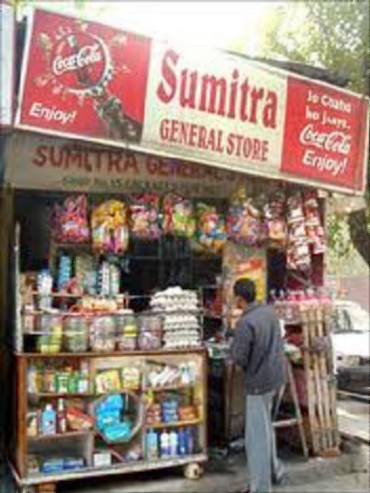Photographs: Courtesy: Accenutre Amit Ranjan Rai in New Delhi
The volatility in commodity and raw materials prices has been a major concern for manufacturing companies globally. In a highly competitive market place, passing on the rise in input costs to the consumer is not always the wisest move.
Companies are trying to absorb the rising costs by investing in consistent supplies. One of the biggest priorities is to make the supply chain more efficient and resilient.
Gianfranco Casati, group chief executive (products), Accenture Global, who heads the company's consulting services business for sectors ranging from consumer goods, automotive and airline to health and life sciences and freight and logistics, says operational efficiencies and growth are two effective ways to counter the impact of commodity price volatility.
Casati and Anish Gupta, managing partner, products operating group, Accenture India, speak about the compelling issues before manufacturers and marketers today.
...
'Mom and pop stores are not simply going away'
A global resource crunch has been affecting commodity prices the world over for some time now. In many cases, commodity prices are up by 100-150 per cent or even more compared to a year or two ago. How severely is it affecting product manufacturing companies?
Casati: It is a big problem and it is global. It doesn't penalise India against others - it is common the world over. It is a problem because the market is not prepared to pay higher prices for finished goods, while raw materials are costing much more.
We see it particularly acute for consumer goods and transportation companies. In transportation, it is affecting airlines in particular.
Every airline client we meet is extremely concerned about the cost of fuel and he doesn't want it to be reflected in the price of tickets. It is an issue but I don't think it will trigger immediate increase in prices, but there is a potential threat.
...
'Mom and pop stores are not simply going away'
Is it not already reflecting in the inflation the country is facing? Is there no connect?
Casati: In the rest of the world, if I look at the mature economies - Europe and North America in particular - there are signs of inflation coming up. And that is an issue because normally when you see inflation, central banks raise the interest rates to cool it down.
As we are just out of a deep recession, companies are still trying to come out of the crisis, and just raising the cost of money is going to put them back in a bad phase.
So the fine balance that central banks are trying to work out is different from the past, and we cannot learn much from the past in this case.
There is going to be a continuous evolution and I expect it to be rather volatile. I mean, they may adjust the interest rates to see how the economy reacts and then move up and down again.
...
'Mom and pop stores are not simply going away'
Image: Anish Gupta, managing partner, products operating group, Accenture IndiaPhotographs: Courtesy: Accenture
Gupta: That's right. The only added dimension is that there is a bit of a supply side issue for India as well.
Our incomes have risen and therefore demand has risen, and I think there is some truth there that our supply sources haven't kept pace and therefore there is going to be that inherent pressure of inflation.
Through appropriate fiscal and monetary policy you might be able to control it, but over the long term the only sustainable answer is that you make sure that your supply and productivity improves.
...
'Mom and pop stores are not simply going away'
What are Indian companies doing to deal with it?
Gupta: First and foremost, companies are doing a lot of soul-searching to what can they do to reduce costs - it is not easy to pass on higher input costs to the consumer.
Second, Indian companies are trying to find, what I would call, higher value markets. Globalisation from an Indian company's standpoint means that you try to get into newer markets where your realisations are better, and therefore, to some extent, by changing your balance of portfolio in that direction, you try to improve on margin.
So, I think, it is a bit of both - while you are try to reduce costs, you take a harder look on managing your portfolio better to generate better results.
The other way to deal with it relates to analytics. That is, how can companies use their internal data more effectively to identify new growth opportunities.
Take the consumer goods space, where we know that distribution is very fragmented. A lot of our clients are looking at how to use the data that resides with them to better target mom and pop stores and increase sales to them.
So there are initiatives both at the macro and micro levels that companies are taking to meet the rising commodity prices.
...
'Mom and pop stores are not simply going away'
The volatility in commodity markets affects the supply chain quite seriously. How can companies make their supply chain more efficient and resilient to such ups and downs?
Casati: The scarcity of certain raw materials or commodities is a fact. The way you can make your supply chain more effective and resilient is by making it more productive - that is, using less stock for the same amount of production.
This is where companies are putting a lot of their efforts.
The second is to put in place a multiple sources structure. A multi-sources strategy not only helps in creating efficiency and cost savings but also surviving the volatilities in commodity or raw material prices.
Such a strategy means having different vendors in different parts of the world. A more strategic relationship with certain vendors in different parts of the world today is a must.
Companies that already had such relationships are benefitting from it now. Others are all looking to fast implement a multi-sources strategy.
...
'Mom and pop stores are not simply going away'
Gupta: Absolutely, those are the things that clients in India too are focusing on. Resilience comes from trying to minimise the stuff in the supply chain; so you reduce your inventories - whether it is raw materials, packaging materials or even finished goods.
And that is partly what companies here are trying to do. The fact is that we are a growing economy and new products are coming in.
So even on the front-end of the supply chain - where you deal with your distributors - you try to minimise the inventory, which in turn helps you withstand the pressures on the back end.
At the same time, as you launch new products, you need to make sure there is not a huge inventory of existing products that needs to be cleared out.
We are helping a large number of our clients in managing their inventories better by making it more responsive to the changing conditions, both at the back-and front-end of the supply chain.
...
'Mom and pop stores are not simply going away'
How should companies decide how much of the rising input costs they should absorb and what they must pass on to the consumer?
Casati: Without squeezing the margins, you mean! As we said, it is about becoming more efficient. You have a higher cost of inputs and the same price for outputs, and you want to keep the same margins.
The way to do it is by becoming more efficient in between the two extremes. Inevitably, being more efficient on the supply chain is what companies are doing.
The other thing they are trying to do is to grow. If you have higher costs of raw materials and the same output price, one way to resolve the equation is to grow - so that you have fixed costs in between, which could be spread out on a much higher number of units.
One of the reasons why companies are so keen to grow today is that they can make synergies, and that is the way they can protect margins without changing price.
Supply chain efficiency and growth are the two answers that companies are trying to provide to this equation that is out of balance.
Gupta: The philosophical point that I would like to add to that is that given the highly competitive nature of industry, gone are the days when you can say (from an Indian standpoint) if there is an increase in input costs I can just off-load it to the consumer.
The fact of the matter is that some can do it better than others, and I can tell you that virtually every Indian company and specially our clients are really looking very hard at how do they absorb to the extent possible the increase in input costs, with, say, marginal increase in the output costs by improving efficiency and growth.
...
'Mom and pop stores are not simply going away'
What are some of the trends you see on the product innovation side?
Casati: Yes, there are other elements of innovation that are more related to products rather than processes. Take the automotive sector, and you see some big discontinuities coming. One is associated with sustainability.
Consumers are becoming sensitive to sustainability and react positively to such offers. So we see more cars today that use fuel more efficiently, use reusable components in manufacturing, are hybrids and so on.
Second is related to mobility. We see a lot of innovations happening in making people more connected while they are on the move. It is all technology driven and confined not to just smart phones.
Money, purchases, data - almost everything can be managed remotely or when you're travelling. Mobility and interconnectedness are big drivers of innovation in products today.
The third, which is less technology driven and more marketing driven, is to create products that are more specialised and can be targeted to specific communities.
Instead of 10 shampoos and 10 soaps in the market, you find hundreds - for different skin types, different seasons and so on. Thus, there is certainly more propensity for the consumer to buy that product.
...
'Mom and pop stores are not simply going away'
Do you see some uniqueness in the way marketers are targeting these specific communities?
Casati: We see a lot of companies creating communities of consumers around specific products. There are automobile companies creating communities for bikers who talk between themselves about bikes, accessories and so on.
This triggers spending and drives companies to create more and more specialised products that go well with specific communities.
The best companies create communities out of the blue - communities that never really existed.
A coffee major, for instance, created a community around espresso on the internet, which scanned through 15-20 different blends with different aromas, tastes and so on. Suddenly, it became extremely successful and found a lot of loyalty for its espresso brands.
...
'Mom and pop stores are not simply going away'
What about innovation on the retail front?
Casati: When it comes to retail, honestly, it is quite sensitive to economic trends. As we have gone through a deep economic recession, the retailer's strategy has been centred on price.
Price has been the main driver of success for retailers over the past three and a half years. Moving beyond the contingency of the crisis, we see a growing trend towards multiple channels, which means companies going for multiple formats for their brands for, say, different retail formats - department store, super markets, hyper markets and so on.
However, a key innovation that stands out is many companies and retailers are using the internet as the direct channel to reach out to consumers. This is happening even in the case or perishable goods.
Major food retailers have organised to have a short supply chain that can deliver replenishments daily or even twice a day.
A further evolution we are seeing is the food retailer bringing your own basket to your house. This is becoming a trend in major North American and European cities.
...
'Mom and pop stores are not simply going away'
There were online retailers that failed at the time of the internet bubble 10 years ago
Casati: Ten years ago the online retailers failed because they didn't have a supply chain infrastructure available.
Now, the model that makes sense is the traditional retailer with an existing supply chain and distribution system adding the direct-to-consumer framework on top, and it seems to work. We see significant innovation happening on this front.
The crisis has made the difference between the consumer and retail collapse to an extent. On the one hand, we see more retailers going for private labels, on the other, more consumer goods companies are going direct to the consumer, skipping the retail channel.
It is obvious in both cases they improve on margins. The private labels don't have to add the 15 per cent on marketing and going direct means you avoid the intermediation margins of retailers.
This dynamics is reshaping the industry, but the change will be gradual because retailers cannot upset consumer goods companies too much and the other way around applies as well.
...
'Mom and pop stores are not simply going away'
How is the Indian retail experience different? How have global models worked in our country?
Gupta: Let's look at grocery or consumer goods retail in the country. India is largely a mom and pop market. It is quite dangerous for companies to blindly adopt global business models here.
Initially, the players that entered organised retail had a perspective that there is high level of inefficiency in the traditional channel and by knocking off intermediary A, B and C, they can make all this money.
The reality is when they entered they found the traditional channel to be quite efficient. So from an organised retail standpoint, most companies are still finding their feet.
Even the biggest retailers in the world are finding India to have some unique challenges.
...
'Mom and pop stores are not simply going away'
So they will have to be innovative both at the back and front end, on the supply chain side and so on.
Even when they are getting supplies from global consumer goods companies, the supply chain efficiencies are nowhere near to what they are globally.
There are a large number of commodities where no consumer goods companies operate. So the retailer has to create a supply chain from scratch to get consistent quality and supplies.
Our mom and pop stores are not simply going to go away. The traditional trade may be growing slower than the modern, but the fact is it is by and far the way most Indian consumers shop.
And there are interesting ways that traditional retail is innovating to keep itself relevant to consumers.
A housewife can call the kirana six times a day and get almost anything, whatever it costs, home delivered. It doesn't have to be a purchase of at least Rs 1,000. So the kiranas are focused on efficient service.
















article